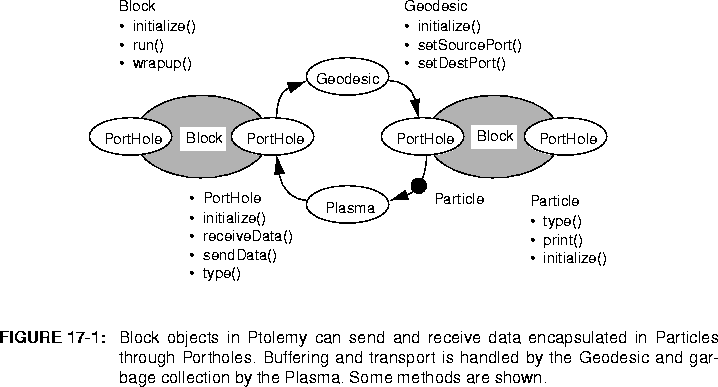Universe is a complete executable system. A Universe can be either a single Galaxy or a collection of disconnected Galaxies. To run a Universe, each Galaxy also needs a Target. In simulation domains, a Target is essentially a collection of methods to compute a schedule and run the various Stars of a Galaxy. Some Domains have more than one possible scheduling algorithm available and the Target is used to select the desired scheduler. In code generation domains, a Target also computes a schedule and runs the individual Stars, but each Star only generates code to be executed later. Code generation Targets also handle compiling, loading, and running the generated code on the target architecture.At a lower level are the connections between
Blocks. A Block is a Star or Galaxy. Each Block has a number of input and output terminals which are attached to a Block through its PortHoles. A special PortHole, called a MultiPortHole, is used to make multiple connections but with only one terminal. Two Blocks are not directly connected through their PortHoles. Rather, their PortHoles are connected to an intermediary object called a Geodesic. In simulation domains, data is passed between PortHoles (through the Geodesic) using container objects called Particles. Ptolemy uses a system where Particles are used and recycled instead of created and deleted when needed. Particles are obtained from a production and storage class called a Plasma, which creates new Particles if there are no old ones to reuse. Particles that have completed their task are returned to the Plasma, which may reissue them at a later request. Graphically, the Star to Star connection is depicted below:
The classes defined above provide most of the functionality necessary for a working domain. One additional class needed by all domains is a
Scheduler to compute the order of execution of the Stars in the Galaxy.Therefore, creating a new Ptolemy simulation domain will typically involve writing new classes for
Stars, PortHoles, WormHoles, Targets, and Schedulers.Creating a new domain is a fairly involved process, and not to be done lightly. The first thing that many users want to do when they see Ptolemy is create a new domain. However, it is often the case that the functionality they need is already in either the SDF or DE domains, or they can merely add a
Target or Scheduler rather than an entire domain.







